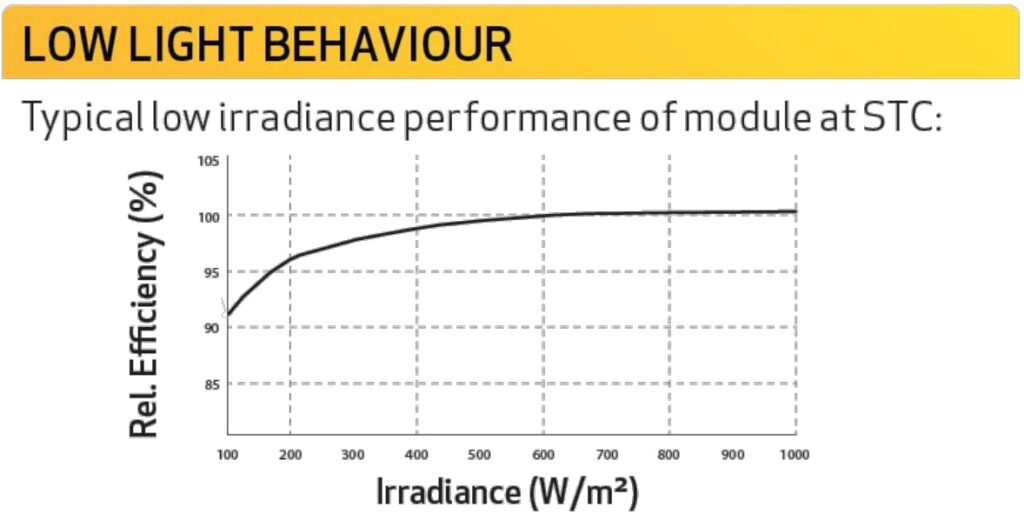It’s been a busy week here at the Sector Ocho support facility. Aside from working three 12 hour days, I also had two days of training tossed in, for a total of 52 hours this week. Let’s see if they pay the overtime or not.
I also got the final engineering report on the solar project. The 24 solar panels have a total surface area of about 500 square feet. That works out to 46.5 square meters. The panels have an efficiency of 22 percent, meaning that we generate a maximum of 10,260 watts at full daylight (full, direct sun is 1,000 watts per square meter). What is interesting is that even in heavy clouds, we still get 230 watts per square meter of sunlight here in Florida (I measured it), and the panels will still produce more than 95% of full output at that light level:

The panels themselves are rated for wind up to 140 miles per hour, and hailstones up to 35mm in diameter.
Now that the engineering report is done, we are applying to the electric company and the city for our operating and construction permits. I have to clear out one side of the garage for the wiring, panels, and mounting of the Tesla powerwalls. Installation should be within the next two to three weeks, depending on permit times.
9 Comments
Rick T · June 22, 2024 at 11:08 am
You have better panels than we did in 2018 (8 panels at 13.7 m^2 got us 2,640W peak) but that is to be expected 6 years later.
Who did you go with for the Inverter(s)? We had a SolarEdge system that worked OK but probably isn’t compatible with a Powerwall that has its own internal inverter.
IcyReaper · June 22, 2024 at 11:14 am
Will enjoy your future updates on the solar. Do you think you could expand on the panels and their efficiency? How did you select them and decide the best efficiency rate vs cost of panels. Are they american or chinese, you know the usual arguments about chinese panels. Me personally I just would want good panels. If we were required to remove all chinese products we wouldn’t have much of anything to choose from in the US.
oldvet50 · June 22, 2024 at 11:23 am
Congrats on your project – hope you get the permission required to undertake this. Please let us know the outcome of your investment – the ACTUAL efficiency vs what you were promised.
Wandering Neurons · June 22, 2024 at 11:38 am
Sounds like what I’m planning for in the Nevada ranch. 24-28 panels, two Powerwall 3 units. Expected out of pocket about $50k, with associated rebated cutting about 1/3 off that. Self-reliance and little to no electric bill afterwards.
DirtpersonSteve · June 22, 2024 at 11:51 am
Thank you for shring this project. We are going to be putting in a bid on 5.5 AC in a southern state very soon. I am treating it like a blank canvas and I will be investigating solar. These posts are very helpful information.
Did you also do solar hot water?
Rusty Miller · June 22, 2024 at 11:59 am
Are you able to share the tech details (panel manufacturer, where purchased, price, etc.) for all of the components of your solar installation? I know that you likely did considerable research for your project, so I’d appreciate it very much if you could share what you learned. Thanks!
Gryphon · June 22, 2024 at 2:35 pm
I would be cautious about having those big Lithium Batteries in the Garage, unless it is Detached form the House. If there is a Fire (not even from the Batteries themselves) the Fire Department will have your Number (from the Electrical Permit) and may just “Let it Burn” because it’s almost impossible to put out a Flammable Metal Fire. Does your AO have a “Powder Truck” (1,000 Pounds of Purple-K) for Electric Car Fires?
Also, is your System going to have ‘Stand-Alone’ Circuitry, so that it can Operate without the Grid Tie? I’ve read that some of those Systems can only run in “Backfeed” Mode, to the Grid. While this reduces the “Electric Bill” you have no Backup Capability,and still need a Portable Genset to keep the Beer Cold.
Divemedic · June 22, 2024 at 3:38 pm
The risks of batteries were discussed in depth with this post. Lithium batteries do not use elemental lithium, but instead use lithium salts. Elemental lithium reacts with water, lithium salts do not.
The belief that solar systems have to shut down stems from the fact that when the grid goes down, the National Electric Code says that our solar system must disconnect from the line so as not to endanger linemen who may be working on the system. That’s where batteries come in. If your system has solar panels and a battery for storing power, you can get a relay installed that will disconnect your system from the grid, thereby allowing your system to act as its own backup power source. This sort of solar system is known as a hybrid system. It was covered in this post here.
Panels – Area Ocho · June 22, 2024 at 12:11 pm
[…] wants to know more about the panels that we selected. I checked through the previous posts and realized that I hadn’t talked about them at all. […]
Comments are closed.